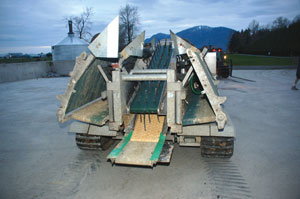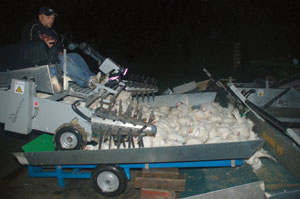
Catching Machines Fill Gap in B.C.
By By David Schmidt
Features Bird Management ProductionKlaas Korthius has imported Ciemme Apollo 60
Klaas Korthius has imported Ciemme Apollo 60 catching machines from Italy

|
| The Apollo 60 catching machines from Italy and the rest of the system can be operated by as few as three people. |
Catching remains the most labour-intensive aspect of broiler production. It is also considered among the least desirable of jobs in the poultry industry. Given that, it is no surprise finding enough good help is becoming more and more difficult.
That is one reason veteran poultryman Klaas Korthius imported several Ciemme Apollo 60 catching machines from Italy.
“I brought the first machine into Canada, Aug 24, 2007, and put it into use two days later,” Korthius says, noting he now has two machines operating in B.C. and one in Saskatchewan.
While three Alberta producers have purchased the Ciemme for use on their own farms, Korthius notes his machines are the first in Canada to be used on multiple farms. “We try to do one farm/night with each machine.
We have now operated the first machine for 950 hours without any difficulty.”
The Ciemme Apollo is not the first automated catching machine in Canada. That honour belongs to the EZ Load system from England, which B.C.’s Sunrise Poultry has been using for over a decade.

|
| The Apollo 60 |
While the EZ Load system uses a long “arm” with a sweeping motion to go through the barn and sweep in the chickens, the Ciemme Apollo looks and acts more like a forage harvester or combine.
Because the machine is track-mounted, it easily traverses both sawdust and straw-based litter. The track mounting also allows it to move straight down a barn without a full-time driver. Designed to be towed on a trailer, once unloaded the harvest head is unfolded to open up to a 20-foot width. Korthius has ordered a second 10-foot-wide head to allow the machine to be used in barns with narrower entries and/or narrower spaces between the posts.
A tiny light bar is located just under the head, which itself rides only centimetres above the surface. The bar provides just enough light to cause the chickens immediately in front of it to stand up. They are then whisked up the belt and onto a cross conveyor. The conveyor deposits the birds into a chute that then fills the catching trays, which are mounted on a trailer. The chute moves up and down and from side to side so each of the individual trays can be filled. The whole system is fully computerized so the system stops momentarily as each tray is filled and the operator moves the chute to the next tray. The trailer holds three modules and the modules are rotated so one is in the fillable position, a second in the empty position and the third loaded tray ready to be removed. By the time the machine gets to the far end of a 200-foot barn, the forklift operator is moving pretty quickly to keep up with removing the filled modules and bringing in the empty trays.

|
| The catcher operates like a forage harvester and can catch and load up to 7,000 birds an hour. |
The entire system can be operated with as few as three people: one to walk alongside the machine to supervise
the system, a second to operate the chute and a third to move the modules in and out.
“The machine can do up to 7,000 birds/hour,” Korthius notes. While that is similar to the output of a
crew of 10 top manual catchers, he notes the machine doesn’t tire. “Unlike a catching crew which often sees
its production drop in half by the end of a shift, the machine is still doing 7,000 birds/hour at the end of the night.”
Even though over 100 birds/minute are almost literally flying through the machine, Korthius says the machine is actually better for the birds than manual catching.
“A European study showed 38 per cent better leg grading and 11 per cent better wing grading with the Apollo than with manual catching.”
 |
| Transferring chicken from the portable catcher to the Apollo 60. |
While the 6,250 kg weight of the machine prohibits its use on upper floors and the width of the catching head precludes its use in small barns, Korthius worked with Ciemme to create a lighter eight-foot-wide, ATV-style catcher to be used in concert with the Apollo. When used in barns with smaller openings the ATV drives into the barn, scoops up the chickens (the catching head works very similarly to the head on the main machine), then delivers them to the main machine, which is still used to fill the trays.
The portable catcher is also light enough to be raised by a forklift and used on an upper floor (if the opening is wide enough). Korthius has also developed a special conveyor that collects the birds from the catcher, in turn feeding them to the main machine. If the main machine can fit into the lower floor of the barn and the upper floor is equipped with drop slots, the conveyor can be inserted into the drop slots, reducing the travel required by the portable catcher.
Chilliwack, B.C., chicken grower Gerry Mammel says the machine has been used at his farm several times and he continues to be impressed with how well it works.
Print this page